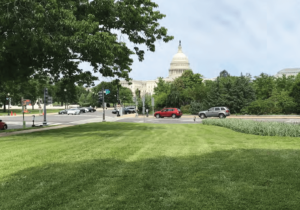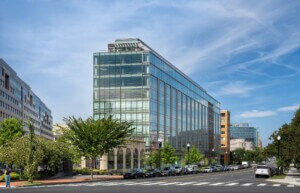Would the FBI headquarters in Washington, D.C., be the best site for the proposed Smithonian’s American Women’s History Museum? Might it be better suited to the new National Museum of the American Latino?
How about the Department of Agriculture Administration Building or the Annex of the Bureau of Engraving and Printing?
Those are a few of the possibilities now under consideration by federal officials and design consultants working to select locations for the two proposed museums.
In 2020, the U. S. Congress authorized the Smithsonian Institution to begin site selection and planning for the museums, asking its Board of Regents for site recommendations by the end of 2022.
On March 3, Smithsonian representatives provided an update to the National Capital Planning Commission and the U. S. Commission of Fine Arts, two panels that review and approve plans for museums and other major projects in Washington, D. C.
The planners said they’ve considered 26 sites and compiled a shortlist of 14 “Tier One” properties that they believe are “more promising” and deserve further evaluation to determine whether they would be suitable for one of the proposed museums.
All 14 sites are close to the National Mall. They fall within two basic groups, sites along the Pennsylvania Avenue N. W. corridor and near L’Enfant Plaza, an area planners call the city’s “Southwest Ecodistrict Area.”
Planners have put the other 12 on a list of “Tier Two” sites that they believe are less likely to meet the museum’s needs as those in Tier One but were still worth consideration and might be feasible for a Smithsonian project in the future. They said one site was recently moved from Tier Two to Tier One.
Ayers Saint Gross of Baltimore is the architecture firm working with the Smithsonian to evaluate candidates.
The Tier One sites include some properties that are already owned by the federal government and others in private hands. They include parcels with no buildings on them, buildings that might be adapted for use as a museum, and buildings that likely would need to be expanded or torn down and replaced.
The list of Tier One sites include:
- Land near the Washington Monument at the northwest corner of Independence Avenue SW and 14thStreet SW
- Land north of the Capitol Reflecting Pool
- Banneker Overlook, a sloping site at the end of the L’Enfant Promenade near G Street S. W.
- The Sidney R. Yates Federal Building, 201 14thStreet S. W.
- The Jamie L. Whitten Building 1400 Independence Avenue S. W., also known as the U. S. Department of Agriculture Administration Building.
- The Arts and Industries Building, 900 Jefferson Drive S. W., already controlled by the Smithsonian
- The James V. Forrestal Building, 1000 Independence Avenue S. W., headquarters of the Department of Energy
- The Forrestal Cafeteria, 1000 Independence Avenue, S. W.
- The Orville Wright Federal Building, 800 Independence Avenue S. W.
- The Wilbur Wright Federal Building, 600 Independence Avenue, S. W.
- The Wilbur Cohen Federal Building, 330 Independence Avenue S. W.
- The U. S. Postal Service Headquarters, 475 L’Enfant Plaza S. W.
- The J. Edgar Hoover Building (FBI headquarters), 935 Pennsylvania Avenue N W.
- The Print Annex of the Bureau of Engraving and Printing, 300 14thStreet S. W.
Tier Two sites included the former Daniel Webster School; the National Museum of Women in the Arts property; the former Corcoran Gallery of Art property; the former Department of Interior South Building; L’Enfant Plaza; the Liberty Loan Building; the Cotton Annex; the National Capital Region headquarters; part of an Internal Revenue Service property; the Department of Labor; the former Walter Reed campus, and Barry Farms.
In the presentations to review groups, some sites got more attention than others, although the Tier One rankings are not complete.
The site that got the most attention was the historic Arts and Industries Building, a National Historic Landmark designed by Adolf Cluss and Paul Schulze and built between 1879 and 1881. Other buildings that got some discussion included the Yates building, the Whitten building and the Print Annex, the structure recently moved from Tier Two to Tier One.
Luanne Greene, the president of Ayers Saint Gross, said in both presentations that the Arts and Industries Building made sense to consider because of its visibility, its distinctive design, and its proximity to the Mall, among other factors.
“Suffice it to say, the Arts and Industries Building is an amazing building with a premier location directly on the National Mall,” Greene said at the NCPC presentation. “The Smithsonian controls it, owns it. Therefore, it has an obvious advantage of availability as a museum site. The AIB is a historic treasure.”
But Greene said the Arts and Industries Building, with about 250,000 square feet of space, was too small to accommodate the program of either museum unless it were expanded or the museums revised their programs to require less space. She said options for expansion include constructing an addition to the south or excavating the basement to create another level underground – “an expensive option but not impossible.”
Many of the sites on Tier One contain buildings that are currently occupied by federal agencies, which would have to be relocated to make way for a museum.
Chief among them is the FBI headquarters at 935 Pennsylvania Avenue, N. W. which opened in 1975. Designed by Charles F. Murphy and Associates, the 11-story building regularly appears on lists of least-admired buildings in the nation’s capital.
During the Obama administration, the U. S. General Services Administration sought proposals from developers interested in moving the FBI headquarters to a new site in either northern Virginia or the Washington suburbs of Maryland
But when Donald Trump became president in 2017, his administration halted planning to move the FBI headquarters just as the GSA was about to announce its preferred site. While federal officials said one reason for stopping the project was lack of funding, there was also strong speculation in Washington circles that Trump didn’t want to see the current site freed up and possibly redeveloped with a hotel that would compete with the Trump International Hotel that his family’s company operated nearby at 1100 Pennsylvania Avenue, N. W.
With Trump out of office, the General Services Administration has been asked to resume planning to relocate the FBI headquarters, taking advantage of the extensive planning work that has already been completed.
According to the Washington Business Journal, a spending bill signed by President Joe Biden this month includes language that restarts the site selection process. The legislation requires the GSA to select a site from three finalists identified before Trump became president; parcels in Greenbelt or Landover, Maryland, or Springfield, Virginia. The FBI and the GSA would then make a report to Congress, which would decide whether to move ahead with construction.
One reason to consider the FBI site, planners said, is that the federal government is working on an initiative to improve Pennsylvania Avenue and make it more conducive for public events and programs, and a museum in the 900 block would be consistent with that effort.
One downside to using the FBI site for a museum, they say, is that the current building most likely would have to be torn down and replaced with one that meets the Smithsonian’s criteria.
Before identifying the sites under consideration, Greene and associate Doug Satteson outlined some of the criteria that the Smithsonian is using to evaluate the different sites.
They said representatives for both museums wanted to be near the National Mall, but advocates for the women’s museum indicated a preference for being toward the eastern end of the National Mall and having views to and from the U. S. Capitol if possible, while advocates for the Latino museum indicated a preference for being more toward the western end of the Mall.
Greene said representatives for both museum groups indicated they would consider occupying an existing structure if the location were “superior.” She said representatives for the women’s museum indicated they would prefer a new building and, if an existing building is adapted, its history “needs to be taken into consideration.”
Site evaluation criteria included: proximity to the National Mall; prominence of the site; significance of the site to constituent groups; visitation potential and proximity to other Smithsonian museums; ability to preserve key view and sight lines, acquisition potential; site conditions such as size, accessibility and “opportunity for architectural expression,” and cost factors such as the extent of site preparation.
One difference between this process and previous ones, several commissioners said, is that the Smithsonian is seeking to identify sites for two museums that will be created at the same time, not just one. They said the Smithsonian’s decision could be transformational for the areas selected.
“Many of the sites that are under consideration will provoke a lot of discussion,” said Peter May of the NCPC. “There’s this potential to create a new critical mass perhaps in a new location, certainly proximate to the Mall, but also breathe some life into some nearby areas that may need a little bit of energy… I’m very encouraged that the Bureau of Engraving and Printing might be back under consideration because I think that’s a site that has tremendous potential.”
“I think there’s a lot of excitement in having two museums moving at the same time,” added NCPC panel member Jennifer Steingasser.
At the Fine Arts Commission presentation, panel member Justin Garrett Moore said he hopes planners consider the amount and quality of land available for outdoor events and programs associated with a museum, as well as indoor spaces. Panel member Peter Cook encouraged the Smithsonian representatives to reach out to as many constituents as possible in the site selection process, so no one feels left out or blindsided.
The next steps, planners say, include additional site evaluation and the development of architectural programming to further reduce the number of potential sites and help determine the best options. A national survey will begin this month, and an update from the Smithsonian is expected this summer.
NCPC chair Beth White said the information that’s being compiled will be helpful even beyond the current site selection process.
“I imagine this will not be the last two museums approved by Congress, so I do encourage the Smithsonian to continue their thoughtful analysis,” White said. “Some of these sites may not work this time around, but they could be good contenders for the future.”











